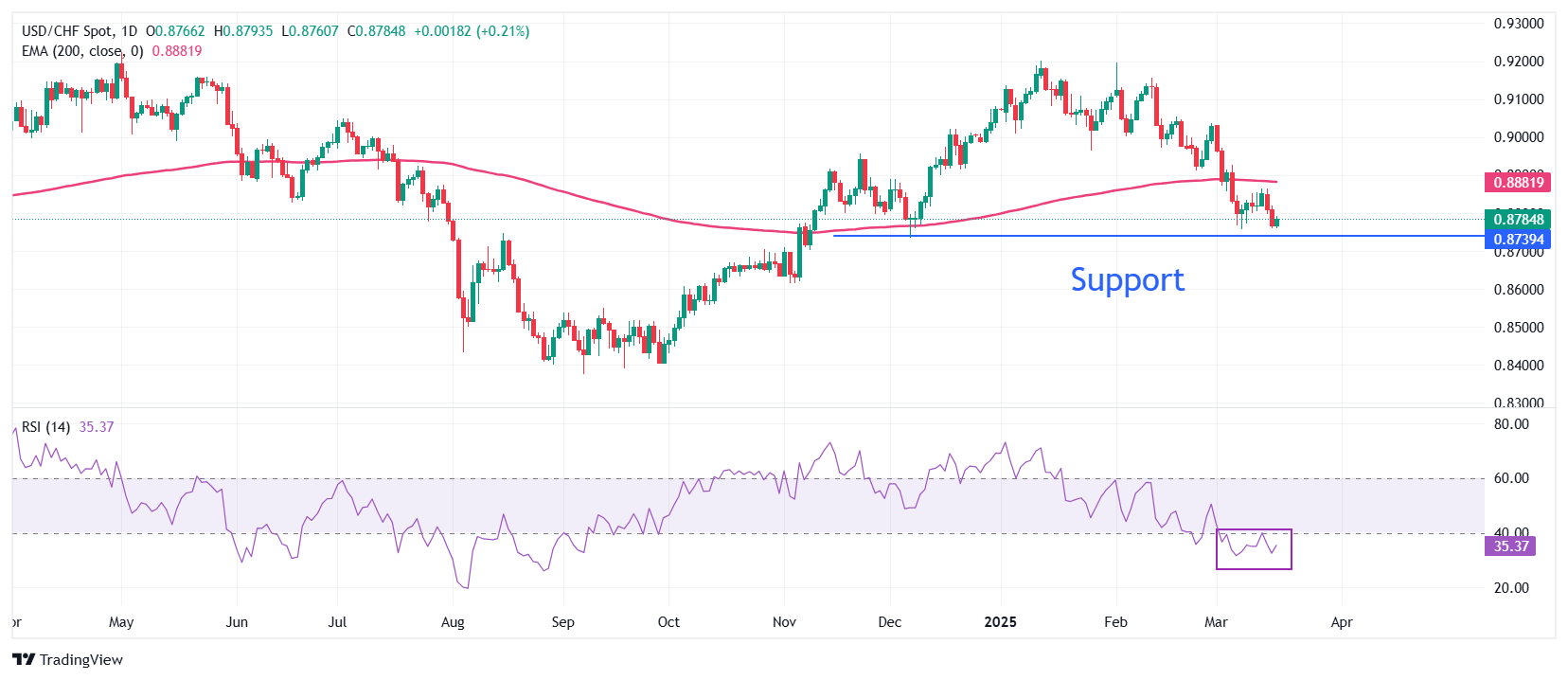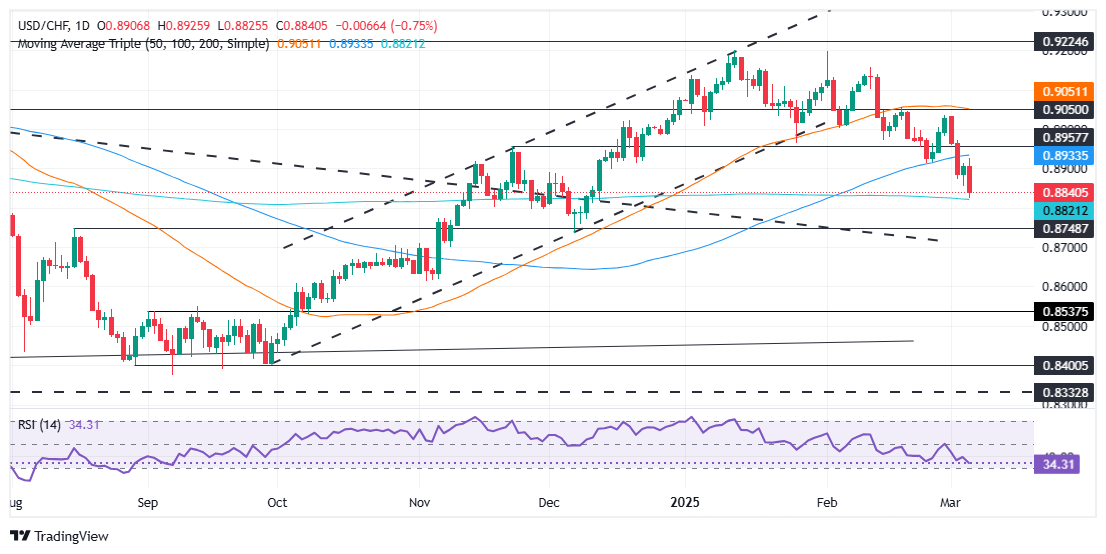- Analytics
- News and Tools
- Quotes
- Chart and quotes for USDCHF
CFD Trading Rate US Dollar vs Swiss Franc (USDCHF)
| Date | Rate | Change |
|---|
Related news
-
20.03.2025 04:53USD/CHF attracts some sellers to near 0.8750 ahead of SNB rate decision
- USD/CHF weakens to around 0.8760 in Thursday’s Asian session.
- The Fed held its benchmark overnight rate steady in the 4.25%-4.50% range.
- The SNB is expected to cut rates by 25 bps at its March meeting on Thursday.
The USD/CHF pair attracts some sellers to near 0.8760 during the Asian trading hours on Thursday. The Greenback edges lower after the Federal Reserve (Fed) indicated interest rate cuts were likely later this year despite the high degree of uncertainty around US tariff policies. Later on Thursday, the Swiss National Bank (SNB) interest rate decision will be in the spotlight.
On Wednesday, the Fed kept interest rates unchanged in a range of 4.25% to 4.5% at its March meeting, as widely expected. The US central bank signaled it will cut rates two more times this year, in line with its previous projection from December.
However, the Fed officials lowered its forecast for economic growth and revised both its inflation projection and unemployment estimates higher. This, in turn, weighs on the USD against the Swiss Franc (CHF). Traders are now pricing in nearly 66 basis points (bps) of rate cuts this year from the Fed, about two rate reductions of 25 bps each, with a cut in July fully priced in, according to the LSEG data.
On the Swiss front, the markets expect the SNB to lower its benchmark interest rate by 25 bps to 0.25% at its policy meeting on Thursday. The decision follows a 50 bps reduction in December and comes amid subdued inflation, a strong CHF, and an uncertain global economic outlook. Nonetheless, worries about the CHF's strength remain, and the Swiss central bank could attempt to alleviate this pressure by cutting interest rates and maybe intervening in the foreign currency market.Swiss Franc FAQs
The Swiss Franc (CHF) is Switzerland’s official currency. It is among the top ten most traded currencies globally, reaching volumes that well exceed the size of the Swiss economy. Its value is determined by the broad market sentiment, the country’s economic health or action taken by the Swiss National Bank (SNB), among other factors. Between 2011 and 2015, the Swiss Franc was pegged to the Euro (EUR). The peg was abruptly removed, resulting in a more than 20% increase in the Franc’s value, causing a turmoil in markets. Even though the peg isn’t in force anymore, CHF fortunes tend to be highly correlated with the Euro ones due to the high dependency of the Swiss economy on the neighboring Eurozone.
The Swiss Franc (CHF) is considered a safe-haven asset, or a currency that investors tend to buy in times of market stress. This is due to the perceived status of Switzerland in the world: a stable economy, a strong export sector, big central bank reserves or a longstanding political stance towards neutrality in global conflicts make the country’s currency a good choice for investors fleeing from risks. Turbulent times are likely to strengthen CHF value against other currencies that are seen as more risky to invest in.
The Swiss National Bank (SNB) meets four times a year – once every quarter, less than other major central banks – to decide on monetary policy. The bank aims for an annual inflation rate of less than 2%. When inflation is above target or forecasted to be above target in the foreseeable future, the bank will attempt to tame price growth by raising its policy rate. Higher interest rates are generally positive for the Swiss Franc (CHF) as they lead to higher yields, making the country a more attractive place for investors. On the contrary, lower interest rates tend to weaken CHF.
Macroeconomic data releases in Switzerland are key to assessing the state of the economy and can impact the Swiss Franc’s (CHF) valuation. The Swiss economy is broadly stable, but any sudden change in economic growth, inflation, current account or the central bank’s currency reserves have the potential to trigger moves in CHF. Generally, high economic growth, low unemployment and high confidence are good for CHF. Conversely, if economic data points to weakening momentum, CHF is likely to depreciate.
As a small and open economy, Switzerland is heavily dependent on the health of the neighboring Eurozone economies. The broader European Union is Switzerland’s main economic partner and a key political ally, so macroeconomic and monetary policy stability in the Eurozone is essential for Switzerland and, thus, for the Swiss Franc (CHF). With such dependency, some models suggest that the correlation between the fortunes of the Euro (EUR) and the CHF is more than 90%, or close to perfect.
-
19.03.2025 10:41USD/CHF Price Forecast: Strives to gain ground near 0.8750 ahead of Fed policy
-
19.03.2025 04:49USD/CHF rebounds above 0.8750, Fed rate decision in focus
-
18.03.2025 05:56USD/CHF holds steady near 0.8800, traders await Fed, SNB rate decisions
-
17.03.2025 05:34USD/CHF attracts some sellers below 0.8850 amid safe-haven flows
-
14.03.2025 04:57USD/CHF attracts some buyers to near 0.8850 on US Dollar’s recovery
-
13.03.2025 06:55USD/CHF remains on the defensive near 0.8800 ahead of US PPI data
-
12.03.2025 23:09USD/CHF Price Forecast: Clings to 0.8800 as bulls eye 200-day SMA
-
12.03.2025 05:35USD/CHF strengthens to near 0.8850 ahead of US CPI inflation release
-
11.03.2025 06:01USD/CHF weakens to near 0.8800 amid tariff worries
-
10.03.2025 14:43USD/CHF Price Forecast: Safe-haven appeal of Swiss Franc improves
-
10.03.2025 05:25USD/CHF dips below 0.8800 as concerns over US growth intensify
-
07.03.2025 05:20USD/CHF weakens below 0.8850 as investors await US NFP data
-
06.03.2025 22:12USD/CHF Price Forecast: Bears moved in, eye 200-day SMA
-
06.03.2025 05:56USD/CHF moves back above 0.8900 mark; upside potential seems limited
-
05.03.2025 08:03USD/CHF remains below 0.8900 following Swiss CPI data release
-
04.03.2025 05:18USD/CHF remains under pressure near 0.8950 as Swiss Franc strengthens on safe-haven demand
-
03.03.2025 05:55USD/CHF trades with mild losses below 0.9050 as traders brace for US PMI release
-
28.02.2025 07:15USD/CHF gathers strength to near 0.9000 as traders brace for US PCE data
-
27.02.2025 05:51USD/CHF attracts some buyers above 0.8950 as traders await US Q4 GDP release
© 2000-2025. All rights reserved.
This site is managed by Teletrade D.J. LLC 2351 LLC 2022 (Euro House, Richmond Hill Road, Kingstown, VC0100, St. Vincent and the Grenadines).
The information on this website is for informational purposes only and does not constitute any investment advice.
The company does not serve or provide services to customers who are residents of the US, Canada, Iran, The Democratic People's Republic of Korea, Yemen and FATF blacklisted countries.
Making transactions on financial markets with marginal financial instruments opens up wide possibilities and allows investors who are willing to take risks to earn high profits, carrying a potentially high risk of losses at the same time. Therefore you should responsibly approach the issue of choosing the appropriate investment strategy, taking the available resources into account, before starting trading.
Use of the information: full or partial use of materials from this website must always be referenced to TeleTrade as the source of information. Use of the materials on the Internet must be accompanied by a hyperlink to teletrade.org. Automatic import of materials and information from this website is prohibited.
Please contact our PR department if you have any questions or need assistance at pr@teletrade.global.



















